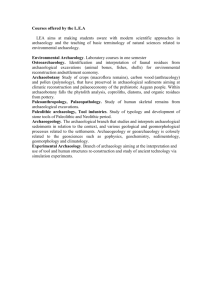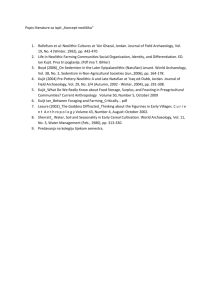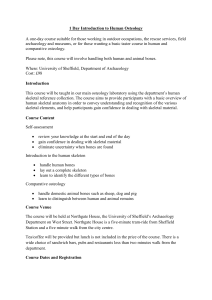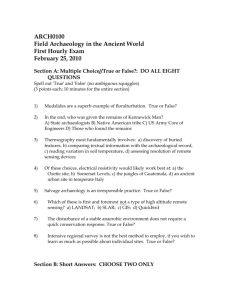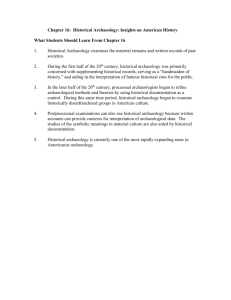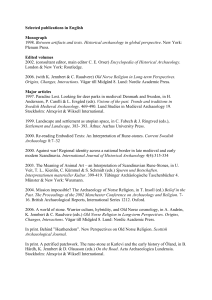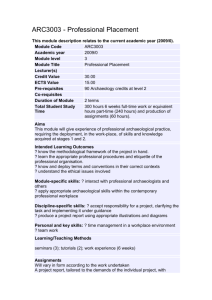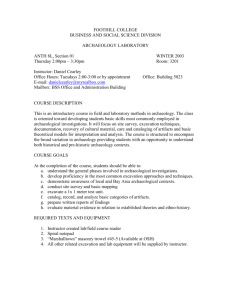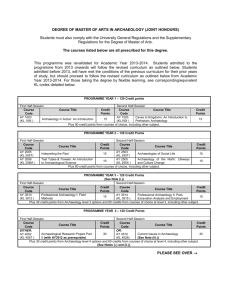St Marylebone bibliography
advertisement
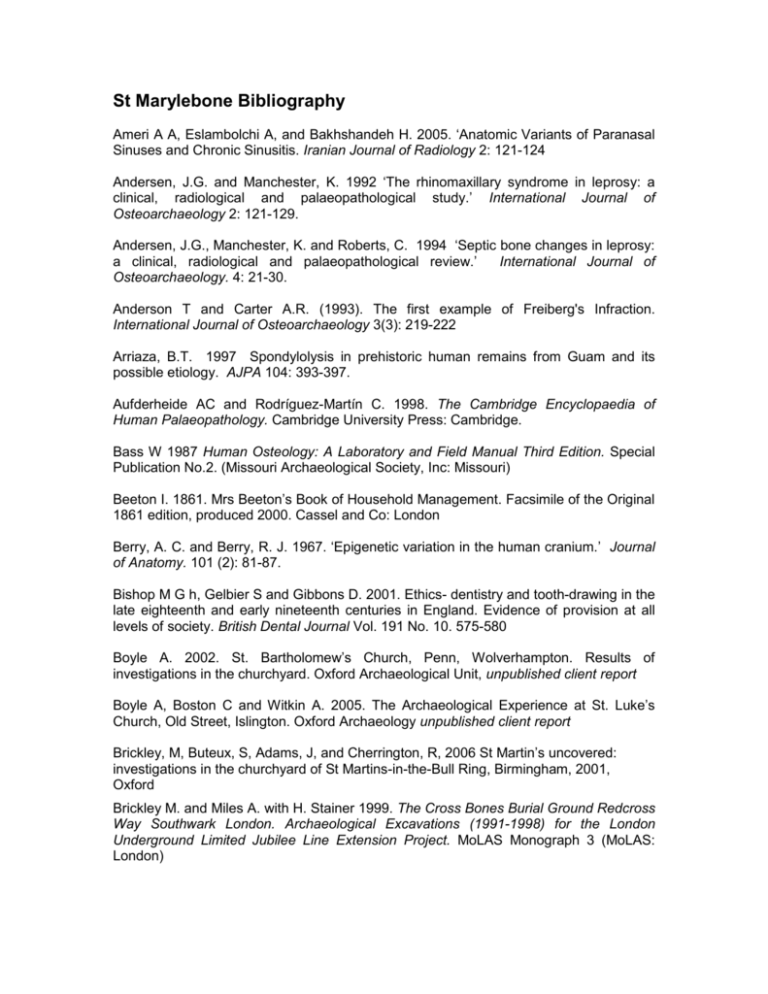
St Marylebone Bibliography Ameri A A, Eslambolchi A, and Bakhshandeh H. 2005. ‘Anatomic Variants of Paranasal Sinuses and Chronic Sinusitis. Iranian Journal of Radiology 2: 121-124 Andersen, J.G. and Manchester, K. 1992 ‘The rhinomaxillary syndrome in leprosy: a clinical, radiological and palaeopathological study.’ International Journal of Osteoarchaeology 2: 121-129. Andersen, J.G., Manchester, K. and Roberts, C. 1994 ‘Septic bone changes in leprosy: a clinical, radiological and palaeopathological review.’ International Journal of Osteoarchaeology. 4: 21-30. Anderson T and Carter A.R. (1993). The first example of Freiberg's Infraction. International Journal of Osteoarchaeology 3(3): 219-222 Arriaza, B.T. 1997 Spondylolysis in prehistoric human remains from Guam and its possible etiology. AJPA 104: 393-397. Aufderheide AC and Rodríguez-Martín C. 1998. The Cambridge Encyclopaedia of Human Palaeopathology. Cambridge University Press: Cambridge. Bass W 1987 Human Osteology: A Laboratory and Field Manual Third Edition. Special Publication No.2. (Missouri Archaeological Society, Inc: Missouri) Beeton I. 1861. Mrs Beeton’s Book of Household Management. Facsimile of the Original 1861 edition, produced 2000. Cassel and Co: London Berry, A. C. and Berry, R. J. 1967. ‘Epigenetic variation in the human cranium.’ Journal of Anatomy. 101 (2): 81-87. Bishop M G h, Gelbier S and Gibbons D. 2001. Ethics- dentistry and tooth-drawing in the late eighteenth and early nineteenth centuries in England. Evidence of provision at all levels of society. British Dental Journal Vol. 191 No. 10. 575-580 Boyle A. 2002. St. Bartholomew’s Church, Penn, Wolverhampton. Results of investigations in the churchyard. Oxford Archaeological Unit, unpublished client report Boyle A, Boston C and Witkin A. 2005. The Archaeological Experience at St. Luke’s Church, Old Street, Islington. Oxford Archaeology unpublished client report Brickley, M, Buteux, S, Adams, J, and Cherrington, R, 2006 St Martin’s uncovered: investigations in the churchyard of St Martins-in-the-Bull Ring, Birmingham, 2001, Oxford Brickley M. and Miles A. with H. Stainer 1999. The Cross Bones Burial Ground Redcross Way Southwark London. Archaeological Excavations (1991-1998) for the London Underground Limited Jubilee Line Extension Project. MoLAS Monograph 3 (MoLAS: London) Brickley, M. 2006 Rib fractures in the archaeological record: a useful source of sociocultural information? International Journal of Osteoarchaeology 16: 61-75. Brickley, M., Buteux, S., Adams, J. and Cherrington, R. 2006 St. Martin’s uncovered. Investigations in the churchyard of St. Martins-in-the-Bull Ring, Birmingham, 2001. Oxbow. Bridges, P.S. 1989 Spondylolysis and its relationship to degenerative joint disease in the prehistoric southeastern United States. American Journal of Physical Anthropology 79: 321-329. Brooks, S.T. and Suchey, J. M. 1990. ‘Skeletal age determination based on the os pubis: a comparison of the Ascadi-Nemeskeri and Suchey-Brooks methods.’ Human Evolution 5: 227-238. Brothwell, D. 1981. Digging Up Bones. (British Museum: London). Buckley H R and Tayles N. 2003. Skeletal Pathology in a Prehistoric Pacific Island Sample: Issues in Lesion Recording, Quantification and Interpretation. American Journal of Physical Anthropology 122: 303-324 Buikstra, J and Ubelaker, D (eds) 1994. Standards for data collection from human skeletal remains. Arkansas Archaeological Survey Research Series, No 44. Byng G. 1781. Letter from the 4th Viscount Torrington, Brussels to W.H.C. Bentinck 3rd Duke of Portland. 23rd May 1781. From Political correspondence of W.H.C. CavendishBentinck, 3rd Duke of Portland (1738-1809); plus miscellaneous correspondence and other papers, 1711-1809. The Portland (London) Collection, The University of Nottingham (nottingham.ac.uk). Chamberlain A. 2000. Problems and Prospects in Palaeodemography. In Cox M and Mays S. (eds.) Human Osteology In Archaeology and Forensic Science. (Greenwich Medical Media Ltd.: London) 101-113 Choi H K, Aitkinson K, Karlson E W, Willett W and Curhan G. 2004 ‘Purine-rich foods, diary and proiten intake and the risk of gout in men’ New England Journal of Medicine Vol 350, No. 11: 1093-1103 Conheeney J. 1992. Scan of human remains collected from Marylebone cemetery. Museum of London Archaeology Service unpublished archive report HUM/ASS/04/92 Connell B, and Rauxloh P 2003. A rapid method for recording human skeletal data (Version 1). Museum of London Specialist Services. Cowie R, Bekvalac J and Kausmally T. In press. Life and Death in Chelsea: excavations at 2-4 Old Church Street Cox M, Chandler J, Boyle A, Kneller P and Haslam R. 2000. Eighteenth and nineteenth century dental restoration, treatment and consequences in a British nobleman. British Dental Journal Vol. 189, No. 11 593-596 Cox M. 1993. Epidemics and skeletal populations: problems and limitations. Epidemic Disease in London. J A I Champion (ed.). (Centre for Metropolitan History Working Paper Series No. 1) 71-79 Cox, M. and Mays, S. (eds.) 2000. Human Osteology In Archaeology and Forensic Science. (Greenwich Medical Media Ltd.: London). De Chemant, N 1804. A dissertation on artificial teeth: evincing the advantages of teeth made of mineral paste, over every denomination of animal substance. To which is added, advice to mothers and nurses on the prevention and cure of those diseases which attend the first dentition. 4th edition (Dulau and Co.: London) Finnegan, M. 1978. ‘Non-metric variation of the Infracranial Skeleton’ Journal of Anatomy. 125: 23-37. Galloway, A (ed) 1999 Broken bones: anthropological analysis of blunt force trauma. Charles C. Thomas: Springfield, IL. Glencross, B. and Stuart-Macadam, P. 2001 Radiographic clues to fractures of distal humerus in archaeological remains. International Journal of Osteoarchaeology 11: 298310. Goaz and White 1987. Oral Radiology: Principles and Interpretation 2nd edition (The C.V. Mosby Company). Gonzalez-Reimers, E., Garcia-Valdecasas-Campelo, E., Santolaria-Fernandez, F., Milena-Abril, A., Rodriguez-Rodriguez, E., Martinez-Riera, A., Perez-Ramirez, A. and Aleman-Valls, M.R. 2005 Rib fractures in chronic alcoholic men: Relationship with feeding habits, social problems, malnutrition, bone alterations, and liver dysfunction. Alcohol 37(2):113-7. Gould G M and Pyle W worldwideschool.org e-book. 1896. Anomalies and Curiosities of Medicine. Gowland R and Chamberlain A. 2002. ‘A Bayesian approach to ageing perinatal skeletal material from archaeological site: implications for the evidence for infanticide in RomanBritain.’ Journal of Archaeological Science 29: 677-685. Grauer, A.L. 1996 Paleoepidemiology, healing, and possible treatment of trauma in the medieval cemetery population of St. Helen-on-the-Walls, York, England. American Journal of Physical Anthropology 100:531-544. Groves S., Roberts C, Johnstone C, Hall R and Dobney K. 2003 A High Status Burial from Ripon Cathedral, North Yorkshire, England: Differential Diagnosis of a Chest Deformity. International Journal of Osteoarchaeology 13: 358-368 Gustafson, G. and Koch, G. 1974. ‘Age estimation up to 16 years of age based on dental development’. Odontologisk Revy. 25: 297-306. Hargreaves A. 2003 Dentistry in the British Isles. In Hillam C. (ed). Dental practice in Europe at the end of the eighteenth century. Clio Medica 72. (Rodopi: New York). 171282 Heberden W. 1801. Observations on the Increase and Decrease of different diseases and particularly of the plague. In Population and Disease in Early Industrial England 1973. Gregg International Publishers Limited. Hershkovitz, I., Bedford, L., Jellema, L.M. and Latimer, B. 1996 ‘Injuries to the skeleton due to prolonged activity in hand-to-hand combat’. International Journal of Osteoarchaeology 6: 167-178. Hillam D.G. 1997. The availability of dental products in Britain at the end of the 18th century. Dental Historian. No.32: 56-65 Hochberg Z. 2003. Introduction: Rickets – Past and Present. In Hochberg Z (ed). Vitamin D and Rickets. Endocr Dev. Basel, Karger vol. 6. 1-13 Janaway R C 1987. ‘The preservation of organic materials in association with metal artefacts deposited in inhumation graces’ In A Boddington, A N Garland and R C Janaway (eds.) Death, Decay and Reconstruction: archaeological approaches to archaeology and forensic science (Manchester University Press: Manchester) 127-148 Judd, J. 2002 ‘Ancient injury recidivism: an example from the Kerma period of ancient Nubia’. International Journal of Osteoarchaeology 12: 89-106. Jung T, Tschernitschek H, Hippen H, Schneider B and Borchers L. 2004. Elongated styloid process: when is it really elongated? Dentomaillofacial Radiology 33: 119-124 Kaufman M.H., Whitaker D and McTavish J. 1997. Differential Diagnosis of Holes in the Calvarium: application of Modern Clinical Data to Palaeopathology. Journal of Archaeological Science 24: 193-218 Knüsel, C.J. and Göggel, S. 1993 ‘A cripple from the medieval hospital of Sts James and Mary Magdalen, Chichester’. International Journal of Osteoarchaeology 3: 155-165. Kurdyk, Bernard. 1999. Guiseppangelo Fonzi: industrial Fabrication Promoter of Porcelain Prosthetics. Journal of the History of Dentistry Vol.47 No.2. 79-92 Lane J. 2001 A Social History of Medicine: health, healing and disease in England 17501950 (Routledge: London) Lewis, M. 2000. ‘Non-adult Palaeopathology: current status and future potential.’ In Cox, M. and Mays, S. (eds.) Human Osteology In Archaeology and Forensic Science (Greenwich Medical Media Ltd: London). P.39-57. Lewis, M. E. 2004. ‘Endocranial lesions in non-adult skeletons: understanding their aetiology’. International Journal of Osteoarchaeology 14: 82-97 Lewis, M.E. 2002 Infant and childhood leprosy: present and past. In The past and present of leprosy (ed Roberts, C.A., Lewis, M.E. and Manchester, K.). BAR int. series 1054. P.163-170. Liversidge, H. M, 1994. Accuracy of Age Estimation from Developing Teeth of a Population of Known Age (0- 5.4 years). International Journal of Osteoarchaeology 4: 37-45. Lovejoy, C., Meindl, R., Pryzbeck, T. and Mensforth, R. 1985. ‘Chronological metamorphosis of the auricular surface of the ilium: a new method for the determination of age at death.’ American Journal of Physical Anthropology. 68: 47-56. Lovell, N.C. 1997 ‘Trauma analysis in paleopathology’. Yearbook of Physical Anthropology 40: 139-170. Maresh, M. M. 1970. ‘Measurements from roentgenograms’. In Mc Cammon, R. W. (ed.) Human Growth and Development. (Charles C Thomas: Springfield) p.157-200. Mathias, P. 1983. The first industrial nation. The economic history of Britain 1700-1914. Routledge. Mays, S 2003 'The Rise and Fall of Rickets in England; in Murphy, P and Wiltshire, P (eds) The Environmental Archaeology of Industry. Oxbow, Oxford, 144-153 Mays, S. & Faerman, M. 2001 Sex determination of putative infanticide victims from Roman Britain. Journal of Archaeological Science 28: 555-559 Mays, S.A. 1996 ‘Healed limb amputations in human osteoarchaeology and their causes: a case study from Ipswich, UK’. International Journal of Osteoarchaeology 6: 101-113. Mays, S 2003 'The Rise and Fall of Rickets in England;, in Murphy, P and Wiltshire, P (eds) The Environmental Archaeology of Industry. Oxbow, Oxford, 144-153 Mays, S.A. 2005 ‘Paleopathological study of hallux valgus.’ American Journal of Physical Anthropology. 126:139-149. Mays, S. Brickley, M. & Ives R. (2006). Skeletal manifestations of rickets in infants and young children in an historic population from England. American Journal of Physical Anthropology. 129:362-374 McRae, R. 2003 Pocketbook of orthopaedics and fractures. Elsevier. Merbs, C.F. 2002 Spondylolysis in Inuit skeletons from Artic Canada. International Journal of Osteology 12: 279-290. Merbs, C.F. 1983 Patterns of activity induced pathology in a Canadian Inuit population. Archaeological Survey of Canada Paper No. 119. Ottawa, National Museums of Canada, p.35. Mirander, R.P.G. 1970 Childhood leprosy. International Journal of Leprosy 38(1): 96. Molleson, T. and Cox, M. 1993 The Spitalfields Project. Volume 2: The Anthropology The Middling Sort. CBA Research Report No 86 Moore W. 2005. The Knife Man: blood, body-snatching and the birth of modern surgery. (Bantam Books: London) Moorees, C. F. A, Fanning, E.A. and Hunt, E.E. (1963). ‘Age variation of formation stages for ten permanent teeth.’ Journal of Dental Research 42: 1490-1502. Moxham R. 2004. Tea: addiction, exploitation and Empire. (Robinson: London). O’Connell, L. 1998 The articulated human skeletal remains from St. Augustine the Less, Bristol. Bournemouth University, Unpublished. Oommen, S.T. 2002 The history of the treatment of leprosy and the use of hydrocarpus oil. In Roberts, C.A., Lewis, M.E. and Manchester, K. The past and present of leprosy. BAR Int. ser.1054 pp.201-4. Ortner DJ 2003. Identification of Pathological Conditions In Human Skeletal Remains. Second edition (Academic Press: London) Pappas, A. M. 1981. ‘Osteochondritis Dissecans’ In Clinical Orthopaedics and Related Research 158: 59-69. Peakman J. 2004. Lascivious Bodies: a sexual history of the eighteenth century. (Atlantic Books: London) Pickard L 2000. Dr. Johnson’s London: coffee houses and climbing boys, medicine, toothpaste and gin, poverty and press-gangs, freak shows and female education. (Phoenix Press: London) Pinter-Bellows S. 1996. Can occupations be suggested using human skeletal remains? In A Devonshire and B Woods (eds.) Woman in Industry and technology, from prehistory to the present day: Current Research and the Museum Experience. Museum of London: London. 131-141 Pohl C. 2006. Museum of London Conservation Department Technical Report (unpublished) Porter R. 1982. English Society in the 18th Century. Penguin Books: London. Powers N. 2005. Assessment of human remains excavated from St Marylebone School. Unpublished archive report HUM/ASS/02/05 Powers, N, and White, W, in prep, Health and disease, in Emery and Wooldridge in prep Redfern R. 2002. Sex and the City: A biocultural investigation into female health in Roman Britain. In Gillian Carr, Ellen Swift and Jake Weekes (eds.) Proceedings of the Twelfth Annual Theoretical Roman Archaeology Conference. (Oxbow). Redfern, R.C. and Roberts, C.A. 2005 Health in Romano-British Urban Communities: Reflections from the Cemeteries. In D.Smith, M.Brickley and W.Smith (eds.), Fertile Ground. Papers in Honour of Susan Limbrey. Association for Environmental Archaeology Symposia No. 22. Oxford: Oxbow Books, 115-129. Resnick, D. 2002 (a). Additional Congenital or Heritable Anomalies and Syndromes. In D. Resnick ed. Diagnosis of Bone and Joint Disorders: Fourth Edition. Vol 5. (W.B.Saunders Company: Philadelphia). 4561-4632 Resnick, D. 2002 (b). Degenerative Disease of Extraspinal Locations. In D. Resnick ed. Diagnosis of Bone and Joint Disorders: Fourth Edition. Vol 2. (W.B.Saunders Company: Philadelphia). 1271-1382 Resnick, D. 2002 (c). Osteomyelitis, Septic Arthritis and Soft tissue infection: organisms. In D. Resnick ed. Diagnosis of Bone and Joint Disorders: Fourth Edition. Vol 3. (W.B.Saunders Company: Philadelphia). 2510-2624 Resnick, D. 2002 (d). Internal derangement of joints. In D. Resnick ed. Diagnosis of Bone and Joint Disorders: Fourth Edition. Vol 4. (W.B.Saunders Company: Philadelphia). 3017-3376 Resnick, D. 2002 (e). Target Area Approach to Articular Disorders: A synopsis. In D. Resnick ed. Diagnosis of Bone and Joint Disorders: Fourth Edition. Vol 2. (W.B.Saunders Company: Philadelphia). 1757-1780 Resnick, D. 2002 (f). Gouty Arthritis. In D. Resnick ed. Diagnosis of Bone and Joint Disorders: Fourth Edition. Vol 2. (W.B.Saunders Company: Philadelphia). 1519-1559 Resnick, D. 2002 (g). Physical injury: Extraspinal sites. In D. Resnick ed. Diagnosis of Bone and Joint Disorders: Fourth Edition. Vol 3. (W.B.Saunders Company: Philadelphia). 2783-2933. Resnick, D. 2002 (h). Osteochondroses. In D. Resnick ed. Diagnosis of Bone and Joint Disorders: Fourth Edition. Vol 5. (W.B.Saunders Company: Philadelphia). 3686-3742 Resnick, D. 2002 (i). Tumors and Tumor-like lesions of bone: inamging and pathology of specific lesions. In D. Resnick ed. Diagnosis of Bone and Joint Disorders: Fourth Edition. Vol 4. (W.B.Saunders Company: Philadelphia). 3763-4128 Resnick, D. 2002 (j). Enostosis, Hyperostosis and Periostitis. In D. Resnick ed. Diagnosis of Bone and Joint Disorders: Fourth Edition. Vol 5. (W.B.Saunders Company: Philadelphia). 4844-4919 Resnick, D. 2002 (k). Paget’s Disease. In D. Resnick ed. Diagnosis of Bone and Joint Disorders: Fourth Edition. Vol 3. (W.B.Saunders Company: Philadelphia). 1947-2000 Roberts C. 2000 (a). Infectious disease in biocultural perspective: past present and future work in Britain. In Cox M and Mays S. (eds.) Human Osteology In Archaeology and Forensic Science. (Greenwich Medical Media Ltd.: London) 145-162 Roberts C. 2000 (b). Trauma in biocultural perspective: past, present and future work in Britain. In Cox M and Mays S. (eds.) Human Osteology In Archaeology and Forensic Science. (Greenwich Medical Media Ltd.: London) 337-356 Roberts C. A. and Cox, M 2003. Health and Disease in Britain: from prehistory to the present day. Sutton Publishing Ltd: Stroud. Roberts CA and Connell B, 2004, Palaeopathology, in Brickley M and McKinley JI (eds) Guidelines to the Standards for Recording Human Remains, BABAO/IFA, 31-6. Roberts, C.A. and Manchester, K. 1995. The Archaeology of Disease. (Alan Sutton Publishing Ltd.: Stroud). Rogers J and Waldron T 1995. A Field Guide to Joint Disease in Archaeology (John Wiley and Sons: Chichester) Rogers, J., Waldron, T., Dieppe, P. and Watt, I. 1987. ‘Arthropathies in Palaeopathology: The Basis of Classification according to Most Probable Cause’. Journal of Archaeological Science. 14: 179-193. Santos A.L. and Roberts C.A. 2001. ‘A picture of tuberculosis in young Portuguese people in the early 20th century: a multidisciplinary study of the skeletal and historical evidence.’ American Journal of Physical Anthropology 115: 38-49. Saunders, S. R. 1989. ‘Non-metric Skeletal Variation’. In Iscan, M.Y. and Kennedy, K. A. R. (eds.) Reconstruction of life from the skeleton. (Alan Liss: New York). Scheuer, J. L. and Black, S. 2000 (b). ‘Development and ageing of the juvenile skeleton’. In Cox, M. and Mays, S. (eds) Human Osteology In Archaeology and Forensic Science (Greenwich Medical Media Ltd: London). P.9-22. Scheuer, J. L., Musgrave, J.H. and Evans S. P. 1980. ‘The estimation of late foetal and perinatal age from limb bone length by linear and logarithmic regression.’ Annals of Human Biology. 7: 257-265. Scheuer, L., Black, S. 2000. Developmental Juvenile Osteology. (Academic Press, San Diego). Schuster G, Lux C J and Stellzig-Eisenhauer A. 2003. Children with Class III Malocclusion: Development of Multivariate Statistical Models to Predict Future Need for Orthognathic Surgery. Angle Orthodontist Vol 73: 2. 136-145 Sehnert KW, Jacobson G and Sullivan K. 1999 ‘Is Mercury Toxicity an Autoimmune Disorder?’ Townsend Letter for Doctors and Patients 100-103 Shermis, S. 1983 ‘Domestic violence in two skeletal populations’. Ossa 9-11: 143-151. Shoemaker, R.B. 2004 The London mob. Violence and disorder in Eighteenth century England. Shortell, D., Kucer, J., Neeley, W.L. and LeBlanc, M. 2001 ‘The design of a compliant composite crutch.’ Journal of Rehabilitation Research and Development 38 (1). Spigelman, M. and Donoghue, H.D. 2003 ‘Palaeobacteriology with special reference to pathogenic mycobacteria’ in Emerging pathogens. Archaeology, ecology and evolution of infectious disease (ed Greenblatt, C. and Spigelman, M.), OUP, P.174-188. Stirland, A. 1986 A possible correlation between os acromiale in the burials from the Mary Rose. Proceedings of the 5th European meeting of the Paleopathology Association, Siena, Italy. pp.327-34. Stirland A. 2000. Raising the Dead: the skeleton crew of King Henry VIII’s great Ship, the Mary Rose. John Wiley and Sons Ltd, Chichester. Stuart-Macadam, P. 1991. ‘Anaemia in Roman Britain: Poundbury camp’ In Bush, H and Zvelebil, M (eds.) Health in Poor Societies. B.A.R. International Series 567. Teh J, Firth M, Sharma A, Wilson A, Reznek R and Chan O. 2003. Jumpers and Fallers: a comparison of the distribution of skeletal injury. Clinical Radiology 58: 482-486 Thwaites C L and Farrar J J. 2003. Preventing and treating tetanus. British Medical Journal 326: 117-118 Townsley, W. 1946. ‘Platymeria’ J. Path. Bact 58:85-88 Trotter, M. 1970.’Estimation of stature from intact long limb bones’. In Stewart, T. D. (ed) Personal Identification in mass disasters. (National Museum of Natural History, Smithsonian Institution: Washington). Tyrrell, A. 2000. ‘Skeletal non-metric traits and the assessment of inter and intra population diversity: past problems and future potential.’ In Cox, M. and Mays, S. (eds.) Human Osteology In Archaeology and Forensic Science. (Greenwich Medical Media Ltd.: London) p. 289-306. Waldron T 1993. A Case-referent Study of Spondylolysis and Spina Bifida and Transitional Vertebrae in Human Skeletal Remains International Journal of Osteoarchaeology 3:55-57 Waldron, T. 1991. The Prevalence of, and the Relationship Between Some Spinal diseases in a Human Skeletal Population from London. International Journal of Osteoarchaeology 1: 103-110. White, W. 1985. The human skeletal remains from the Broadgate site LSS85. Museum of London Archaeology Service unpublished archive report HUM/REP/01/87 Wiltse, L.L., Widell, E.H. and Jackson, D.W. 1975 Fatigue fracture: the basic lesion in isthmic spondylolisthesis. . J. Bone Joint Surgery 57A: 17-22. Wood JW, Milner GR, Harpending H and Weiss KM 1992. ‘The Osteological Paradox: problems of inferring prehistoric health from skeletal samples.’ Current Anthropology Vol33, No 4 343-370. Woodforde J. 1968. The Strange Story of False Teeth. (Routledge and Kegan Paul: London) www.georgiantimes.homestead.com/Files/Sport/boxing.html. Zaki HS, Greco CM, Rudy TE and Kubinski JA. 1996. Elongated styloid process in a temporomandibular disorder sample: prevalence and treatment outcome. Journal of Prosthetic Dentistry. 75 (4): 339-405
